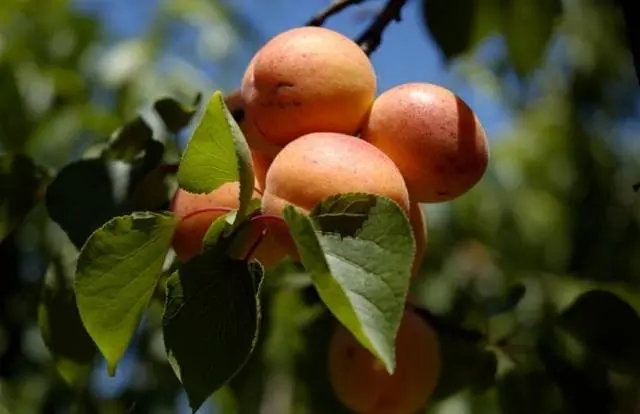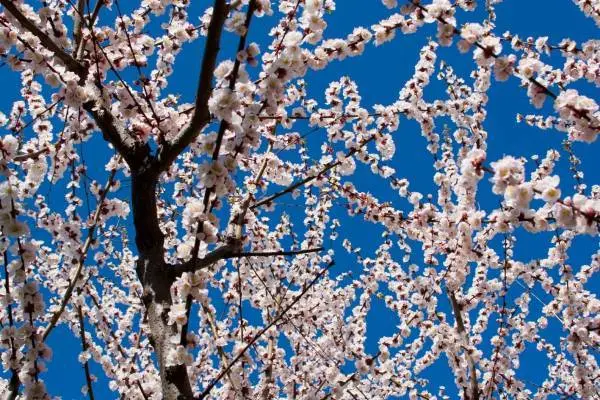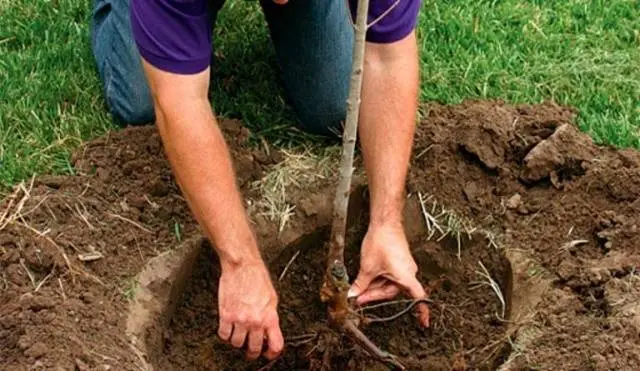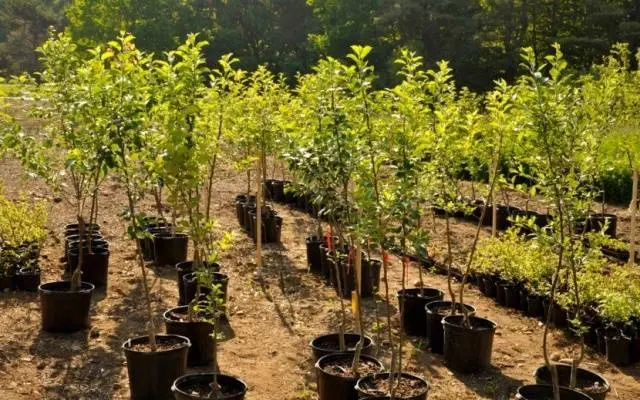Contents
Apricot Alyosha is one of the earliest varieties grown in the Moscow region and central Our Country. You can enjoy sweet fruits already in mid-July. Small fruits are used fresh, for conservation and processing. Growing apricot Alyosha does not require much effort.
History of breeding
The first mention of the variety dates back to 1988. Domestic breeders Skvortsov and Kramarenko presented a new variety of apricot tree. The main task that the scientists set themselves was to obtain a frost-resistant variety of early ripening, suitable for growing in the middle lane. In 2004 apricot Alyosha was included in the State Register of Breeding Achievements. During its existence, the variety has gained considerable popularity in the Central region.
Description of the culture
The tree is distinguished by a spreading crown of a rounded shape, reaching a height of 3-3,5 meters. On strongly branched shoots, many flowers up to 4 cm in diameter are formed. The color of the petals is white with thin veins of pink. The budding period falls on the end of April – the beginning of May.
The average weight of one apricot does not exceed 15 gr. The pulp is characterized by a rich yellow-orange color and a sweet and sour taste. The peel is smooth, with a small amount of villi. The shape of the fruit is round, slightly flattened laterally. As you can see in the photo of Alyosha apricot, ripe fruits have a reddish tint.

In accordance with the description of the Alyosha apricot variety, the pulp of the fruit contains many useful substances. The fruits are rich in beta-carotene and potassium, its content reaches 380 mg per 100 g. Solids and sugars are 14% and 8,3% respectively. The stone is quite large compared to other varieties, it is easily separated. Its weight is about 16% of the total weight of the apricot.
Features
The variety is intended for cultivation in the Moscow region and other regions of the middle lane. In an appropriate climate, a fruit tree produces a stable harvest of apricots every year, without requiring much effort from the gardener.
Drought resistance, winter resistance
An unpretentious variety perfectly tolerates frosty winters. If the air temperature is low in spring, it is recommended to whitewash the tree trunk in time to delay flowering. A distinctive characteristic of the Alyosha apricot variety is the ability to endure dry weather. A prolonged decrease in soil moisture may slightly affect the taste of the fruit.
Pollination, flowering period, ripening period
A variety of fruit tree begins to bear fruit in 3-4 years. Ovaries are formed on all types of shoots. The flowering period, as a rule, falls on the third decade of April or early May. Pollinators for Alyosha apricot are not required. A self-fertile variety can itself act as a pollinator for other apricot trees. During flowering, the entire crown is strewn with large flowers.

Early fruit ripening begins in mid-summer. From the second half of July to mid-August, the technical ripeness of apricots begins. The yield of the variety is high, it is more than 40c/ha.
Scope of fruits
Apricots of the Alyosha variety are consumed fresh, compotes and jams are prepared from them. The crop harvested from the branch can be stored for a long time and not deteriorate. Fruits are suitable for transportation over short distances.
Disease and pest resistance
The Alyosha variety demonstrates high immunity to diseases characteristic of fruit trees, especially to monoliosis and clasterosporiosis. These fungal diseases lead to premature death and shedding of foliage and ovaries. The reason for the spread of diseases is sharp fluctuations in temperature and high humidity.
Reviews of gardeners about Alyosha apricot indicate resistance to pests. With proper care and suitable climatic conditions, the tree does not need additional protection.
Advantages and disadvantages
Alyosha is a popular variety for growing in central Our Country.
Apricot received recognition from gardeners due to several advantages:
- early fruit ripening;
- the ability to tolerate winter temperature drops to -30 ° C;
- resistance to pests and diseases;
- high yield and taste of ripe apricots;
- transportability and keeping quality of fruits.
In accordance with the description of the Alyosha apricot, the only drawback is the large mass of the stone, which increases the percentage of waste during fruit processing.
Features of landing
The survival rate of a seedling when planting an apricot Alyosha and further fruiting depends on how competently the preparatory work was carried out. What matters is the quality of planting material, the place and timing of disembarkation, and compliance with the basic rules of care.
Recommended dates
Seedlings with an open root system must be planted in a permanent place in March-April. At this time, the soil should be warmed up by 5-10°C. As the soil warms up, the active growth of the root system and young shoots will begin.

Planting material with a closed root system can be planted from spring to mid-August. Later landing dates are undesirable. Before the onset of frost, the tree will not have time to take root sufficiently and will die with the onset of frost.
Choosing the right place
The yield of Alyosha apricot is influenced by the area where it grows. You should choose a sunny place, protected on the north side by buildings or other trees. It is allowed to plant apricot on a small slope. In the shade, the Alyosha variety reduces the number of ovaries, and the fruits grow sour and hard.
The root system of a fruit tree grows close to the surface of the earth. It is not advisable to plant a crop in a flooded area with a close occurrence of groundwater. This will lead to cracking of the trunk and rotting of the roots.
What crops can and cannot be planted next to an apricot
A fruit tree can be combined in the garden with early flowers, the vegetation of which takes place at a time when there is little foliage on the branches. Tulips, crocuses, daffodils feel good under apricot trees. Unwanted neighbors in the area – currants and raspberries. Shrubs draw essential nutrients from the soil. When planting the Alyosha variety, it should be borne in mind that its horizontal root system needs a lot of space.
Selection and preparation of planting material
For planting, seedlings aged 1-2 years should be selected. They take root better, tolerate frosts and spring frosts more easily. The root system should be developed, smooth, without growths. Seedlings stored since autumn, before planting, are cut to a third of the length, damaged and dry root processes are removed. In nurseries, Alyosha apricot seedlings are sold in containers with soil. Such trees take root well at any planting time.

Landing algorithm
Apricot planting is carried out subject to several requirements:
- A pit for a seedling is dug to a depth of 70 cm, drainage is laid at the bottom.
- A hill is formed from a fertile layer of soil and fertilizers, on which a seedling is placed, carefully straightening the roots.
- The root neck is left at a height of 5 cm above the ground.
- At a distance of 15-10 cm, a peg as high as a seedling is driven in.
- The soil around the neck is carefully tamped and spilled with plenty of water.
A properly planted tree takes root within 1 month and begins to grow green mass.
Culture aftercare
Alyosha apricot care is quite simple. Compliance with agricultural technology allows you to achieve high yields for many years. One of the points of care is the formation of the crown. On a young tree, 5-6 main shoots are left, shortening them by 1/3. Skeletal branches should form an even crown on all sides. Then it is necessary to carry out formative pruning of regrown shoots every autumn.
In the spring, before the budding period, the tree can be fed with nitrogen fertilizers. It is recommended to use organic matter as a source. In autumn, potassium salt with superphosphate is added under the apricot. To protect against pests, the trunk is whitewashed and wrapped with a nylon mesh. Watering is necessary for a fruit crop in the first half of the growing season and during a prolonged drought.
Diseases and pests
The Alyosha variety is distinguished by high immunity. The fruit tree is resistant to fungal diseases often found in its fellows. As a preventive measure, it is recommended to carry out sanitary pruning of dry, damaged shoots in a timely manner, spray trees with fungicides if there are diseased specimens in the garden. Every autumn, the lower part of the trunk should be treated with whitewash to repel pests.

It is advisable to periodically dig up the ground around the tree in order to destroy caterpillars and harmful larvae. Apricot foliage is recommended to be regularly inspected for the presence of aphids or codling moth. To control pests, it is necessary to spray the trees with insecticides.
Conclusion
Apricot Alyosha allows you to get an excellent harvest of fruits without much labor. Caring for a fruit tree does not require a lot of time from the gardener due to its disease resistance, ability to tolerate drought and frost. Pollination of Alyosha apricot occurs regardless of the presence of insects. The variety produces a large number of tasty fruits suitable for conservation, storage and fresh consumption.
Reviews of gardeners
On the Internet you can find various reviews about the Alyosha apricot in the Moscow region. Gardeners share their experience of growing varieties.
More information about the features of growing apricots in the Moscow region is described in the video clip.









